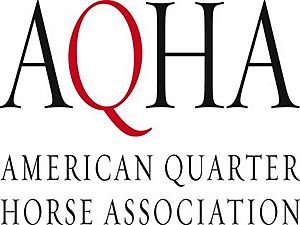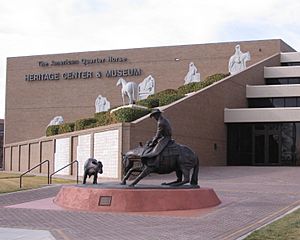American Quarter Horse Association facts for kids

American Quarter Horse Association logo
|
|
|
American Quarter Horse Association
|
|
| Abbreviation | AQHA |
|---|---|
| Formation | March 14, 1940 |
| Legal status | Association |
| Headquarters | Amarillo, Texas, United States |
|
Region served
|
Worldwide |
|
Membership
|
232,162 |
|
President
|
Jeff Tebow |
|
CEO
|
Karl Stressman |
The American Quarter Horse Association (AQHA) is a big group based in Amarillo, Texas, United States. It works to protect, improve, and keep records of the American Quarter Horse. This organization holds many horse competitions and keeps the official list of all registered Quarter Horses. It also has the American Quarter Horse Hall of Fame and Museum and offers learning programs. The AQHA started in 1940 in Fort Worth, Texas. Today, it has almost 235,000 members, with over 32,000 from other countries.
Contents
History of the AQHA

The American Quarter Horse Association began at a meeting on March 15, 1940, in Fort Worth, Texas. The idea came from articles written by Robert M. Denhardt in the 1930s. These articles talked about the history and special traits of the Quarter Horse.
In 1939, Denhardt suggested in Western Horseman magazine that people interested in creating a horse registry should meet. About 75 people gathered in Fort Worth to discuss the idea. They decided to form a non-profit group in Texas to keep horse records. Thirty-six people bought shares in the new organization at that first meeting. They also chose a board of directors and leaders.
Early Challenges and Other Groups
For the first five years, AQHA was the only group registering American Quarter Horses. However, there were disagreements about which horses could be registered. People also argued about how much non-Quarter Horse blood was allowed in the breed.
Another issue was that only stock owners could vote in AQHA. Some breeders felt this gave too much power to a few people. Horse racing was also a big topic. Breeders and owners who raced their Quarter Horses wanted the association to support their needs more. These racing fans also wanted to add more Thoroughbred blood to the Quarter Horse breed. Some felt AQHA was too strict about allowing outside blood.
Because of these disagreements, two other groups were formed. The American Quarter Racing Association (AQRA) started on February 1, 1945. This group mainly focused on horse racing. They set rules for races and created a system to help with handicapping. They registered horses from AQHA's books, plus Thoroughbreds. They even registered "Paint" horses, which did not have their own registry yet. For example, Painted Joe, a famous horse for the American Paint Horse Association (APHA), was registered with AQRA. He raced against many early Quarter Horses.
In December 1945, the National Quarter Horse Breeders Association (NQHBA) was formed. This group was started by people who thought AQHA's rules for registering horses and membership were too strict. NQHBA's rules were much more relaxed than AQHA's. They even registered Thoroughbreds and their crosses freely.
Merging for Strength
Leaders within AQHA realized that having three separate organizations was weakening the Quarter Horse community. All three groups began to talk about joining together. In July 1949, AQHA offered to merge with both AQRA and NQHBA.
AQRA voted to merge with AQHA in September 1949. NQHBA also agreed to merge in November 1949. AQHA then took over both organizations. All their records were moved to AQHA's main office in Amarillo, Texas. The AQHA had moved to Amarillo in 1947. Their first owned building was built in 1952. They stayed there until the Hall of Fame was built in 1989.
How Horses Are Registered
Today, AQHA registers the babies of other American Quarter Horses in its main record book. However, AQHA does not have a completely closed book. There is also an "Appendix" section. An "Appendix" American Quarter Horse is a horse that is a first-generation mix of a registered Thoroughbred and an American Quarter Horse. It can also be a mix of a "numbered" American Quarter Horse and an "appendix" American Quarter Horse.
Horses in the "appendix" can earn their way into the main record book. They do this by meeting many performance goals in racing or horse shows. This earns them a "Register of Merit" (ROM). Currently, over 2.8 million Quarter Horses are registered. About 430,000 of these are international.
Modern Registration Rules
Horses born using artificial insemination or embryo transfer can be registered. However, cloned horses cannot be registered. Now, a horse's parents are checked using DNA testing.
In recent years, AQHA's registration rules have changed a lot. In the past, horses with too much white on their bodies or with certain light colors like cremello could not be registered. This was partly because people did not fully understand equine coat color genetics. For example, they didn't know that Palomino is a lighter version of the cremello gene. There was also a worry about a health problem called lethal white syndrome, which was not fully understood then. Some also believed that too much white meant the horse was not a "pure" Quarter Horse.
Today, modern DNA testing makes it possible to check a horse's parents. It also helps find certain genetic diseases like lethal white syndrome. Because of this, AQHA now allows horses with "high white" markings. These include patterns like sabino and other pinto spots. Many horses that used to only be registered as American Paint Horses with APHA can now be registered with both groups. Also, since the genetics of palomino are understood and not linked to lethal white, colors like cremello and perlino are now allowed.
It is often helpful for horses with these special colors to be registered with more than one group. This includes APHA, the Palomino Horse Breeders of America (PHBA), and the American Buckskin Registry Association (ABRA).
AQHA is also working to stop registering horses that carry the dominant genetic disease hyperkalemic periodic paralysis (HYPP). In 2007, AQHA supported research that created a genetic test for HERDA.
Competitions and Awards
AQHA gives many awards to American Quarter Horses and their owners for their achievements. Some awards are given every year, while others are for lifetime accomplishments. AQHA gives points to horses that do well in horse shows, rodeos, and horse racing. The number of points depends on how well the horse places and how many other horses were in the event. These points lead to yearly awards for top competitors and special lifetime awards for both horses and riders.
AQHA Affiliates
As of 2023, AQHA has related groups in 49 US states, 7 Canadian provinces, and 34 other countries.
Horse Shows and Rodeos
People today show American Quarter Horses in many different events. These include halter classes, where horses are judged on their looks. There are also western style events like Western Pleasure, Reining, and cutting. English riding events are also popular, such as Hunter Under Saddle, working hunter, and hunter hack. Some shows also have driving classes and timed games. There are also classes like equitation and halter showmanship for non-professional riders.
The biggest AQHA event each year is the annual AQHA World Show. It is held every November in Oklahoma City.
In the show ring, AQHA gives out many year-end awards. These include Rookie of the Year, which is given at state, regional, and national levels. There are also Year End Top-Ten awards and High Point awards for different divisions like Open Junior Horse, Open Senior Horse, Youth, and Amateur. Lifetime awards include the Register of Merits in Performance and Halter, AQHA Champion, AQHA Performance Champion, and Supreme Championships.
AQHA also recognizes horses that compete in events not directly run by AQHA. Some awards go to horses in Professional Rodeo Cowboys Association (PRCA) timed rodeo events. Others are for horses in the United States Team Penning Association, National Cutting Horse Association, or the National High School Rodeo and National Intercollegiate Rodeo Association.
Racing Achievements
For horse racing, AQHA gives year-end champion awards based on age and sex. There are also awards for broodmares, distance horses, Canadian champions, owners, breeders, trainers, and jockeys. For example, there is a champion two-year-old colt, filly, and gelding. The World Champion is chosen from the winners of these age and sex groups.
Besides the year-end awards, there are three lifetime awards for racing: Race Register of Merit, Superior Race Horse, and Supreme Race Horse. A Race Register of Merit is given when a horse reaches a speed index of 80 or higher. A Superior Race Horse award is earned when a horse gets 200 racing points. To earn a Supreme Race Horse award, a horse must win over $500,000, win two Grade 1 stakes races, and win a total of ten races.
In 1993, AQHA started Quarter Horse racing's first series of races with a championship day. This is called The Bank of America Racing Challenge. It includes 60 races across North and South America. The winners of each race earn a spot in the season-ending Championship Day. The Bank of America Racing Challenge currently offers almost $6 million in prize money and bonuses.
Pleasure Riding Program
AQHA also has a Horseback Riding Program. This program rewards AQHA members for pleasure riding their American Quarter Horses. Riders keep track of their riding hours and receive special awards and prizes. To join, the horse must be registered with the AQHA, and its registration number and name are needed.
See also


